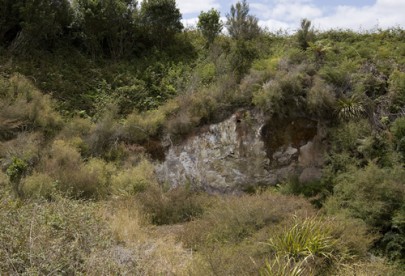Hydrothermally altered ground (now cool)
In this section

Hydrothermally altered ground (now cool) at Mokai, north–west of Taupo, with prostrate kanuka persisting (Mark Smale)
Hydrothermally altered soils have been changed by geothermal steam and are highly infertile, being strongly acidic, with low amounts of organic matter and phosphorus, and sometimes high concentrations of metals and trace elements (Given 1980). This ecosystem is dominated by scrub, mostly of prostrate kanuka (Kunzea ericoides var. microflora).
Notable flora and fauna
Threatened and rare plants include the nationally critical flying duck orchid (Sullivania minor), the declining native ladder fern (Nephrolepis flexuosa) and the naturally uncommon red-bearded orchid (Calochilus robertsonii), Fimbristylis velata, Dicranopteris linearis and prostrate kanuka (Kunzea ericoides var. microflora).
Threat status
Critically endangered (Holdaway et al. 2012)
Threats
Wilding pines (Pinaceae), blackberry (Rubus fruticosus) and broom (Cytisus scoparius) can be problematic in marginal areas where the soils are sufficiently cool for their establishment, although the most heated soils tend to have few naturalized species. Geothermal areas are generally too unstable for urbanisation; however, they have been used as dumping grounds. In more stable areas, stock may trample vegetation when unfenced. Rabbits and hares are present in many geothermal ecosystems. Geothermal fluid extraction for energy can affect surface activity and change soil temperatures with consequent impacts on plant communities. Geothermal fluid extraction can also cause subsidence. Naturally occurring eruptions often destroy vegetation, as can infrequent fires. In places where these areas are used for recreational activities, e.g., motocross riding, considerable damage can result. There are some impacts from tourism, but usually these impacts are well controlled.
Where do they occur?
Hydrothermally altered ground occurs primarily in the Taupo Volcanic Zone on the Volcanic Plateau, in the central North Island.
Further reading
Burns BR 1993. Bryophytes and lichens of Te Kopia Scenic Reserve geothermal vegetation. New Zealand Botanical Society Newsletter 34: 8-9.
Burns BR 1997. Vegetation change along a geothermal stress gradient at the Te Kopia steamfield. Journal of the Royal Society of New Zealand 27: 279-294.
Given DR 1980. Vegetation on heated soils at Karapiti, central North Island, New Zealand and its relation to ground temperature. New Zealand Journal of Botany 18:1-13.
Wardle P 1991. Vegetation of New Zealand. Cambridge University Press. Pp. 400-404.
Wildland Consultants 2011. Geothermal vegetation of the Waikato Region - An update based on 2007 aerial photographs. Wildland Consultants Ltd Contract Report No. 2348. Prepared for Waikato Regional Council. 515 pp.
Links
Geothermally altered ground (Environment Waikato)


